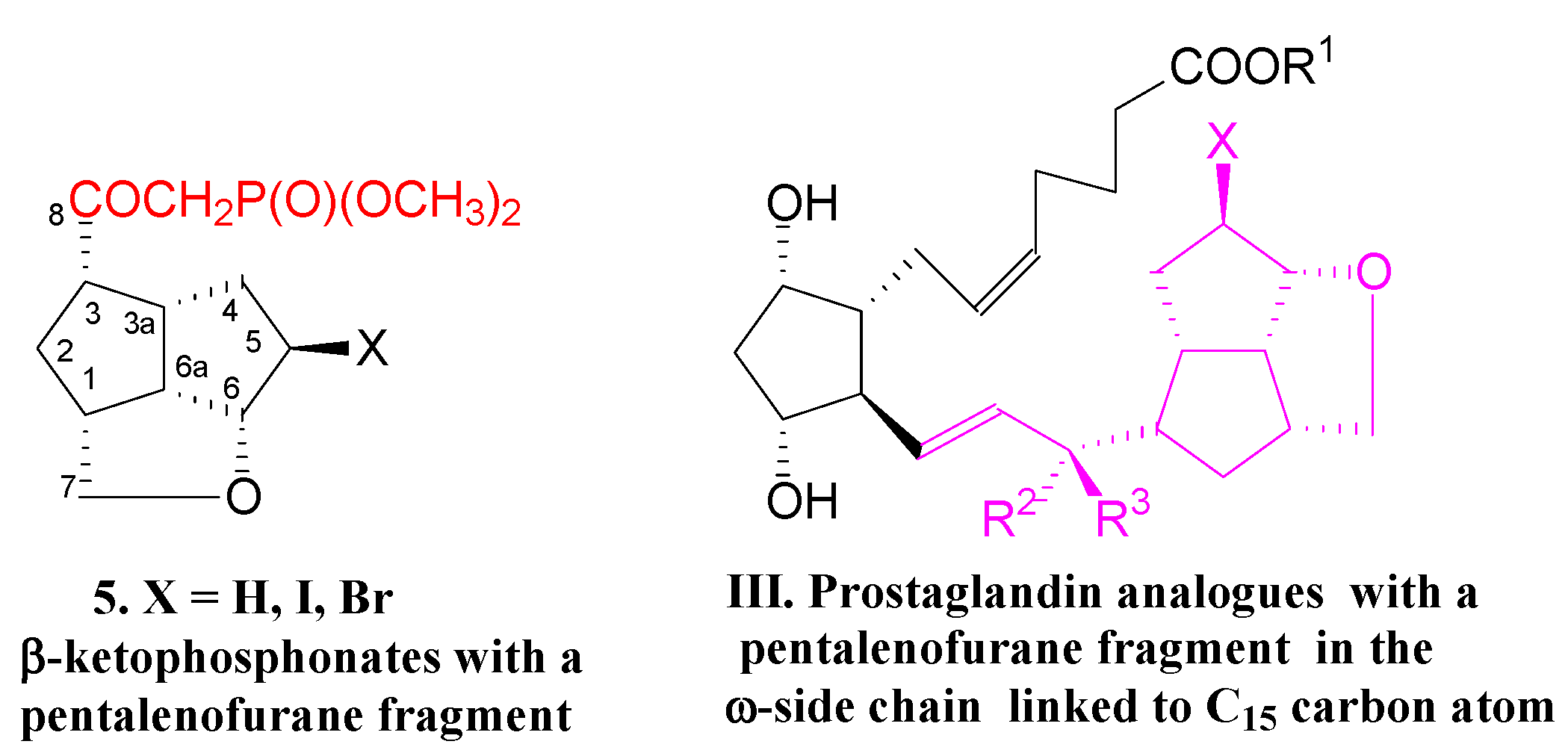Key Intermediates for Building the ω-Side Chain of Prostaglandins with a Constrained Pentalenofurane Scaffold Linked to C-15 Carbon Atom to Diminish the PG Inactivation †
1. Introduction
2. Materials and Methods
3. Results
4. Conclusions
Funding
Data Availability Statement
Acknowledgments
Conflicts of Interest
References
- Tănase, C.; Drăghici, C.; Căproiu, M.T.; Hanganu, A.; Borodi, G.; Maganu, M.; Gal, E.; Pintilie, L. β-Ketophosphonates with Pentalenofuran Scaffolds Linked to the Ketone Group for the Synthesis of Prostaglandin Analogs. Int. J. Mol. Sci. 2021, 22, 6787. [Google Scholar] [CrossRef] [PubMed]
- Tănase, C.I.; Căproiu, M.T.; Drăghici, C. New β-ketophosphonates for the synthesis of prostaglandin analogues. 1. Phosphonates with a bicyclo[3.3.0]octene scaffold spaced by a methylene group from the β-ketone. Prostaglandins Leukot. Essent. Fat. Acids 2021, 173, 102325. [Google Scholar] [CrossRef] [PubMed]
- Tănase, C.I.; Drăghici, C.; Caproiu, M.T. New ß-ketophosphonates for the synthesis of prostaglandin analogues. 2. Phosphonates with a bicyclo[3.3.0]octene and bicyclo[3.3.0]octane scaffolds linked to the ß-ketone group. New J. Chem. 2020, 44, 20405–20410. [Google Scholar] [CrossRef]





Publisher’s Note: MDPI stays neutral with regard to jurisdictional claims in published maps and institutional affiliations. |
© 2022 by the authors. Licensee MDPI, Basel, Switzerland. This article is an open access article distributed under the terms and conditions of the Creative Commons Attribution (CC BY) license (https://creativecommons.org/licenses/by/4.0/).
Share and Cite
Tanase, C.; Draghici, C.; Caproiu, M.T.; Hanganu, A.; Borodi, G.; Maganu, M.; Gal, E.; Pintilie, L. Key Intermediates for Building the ω-Side Chain of Prostaglandins with a Constrained Pentalenofurane Scaffold Linked to C-15 Carbon Atom to Diminish the PG Inactivation. Chem. Proc. 2022, 7, 84. https://doi.org/10.3390/chemproc2022007084
Tanase C, Draghici C, Caproiu MT, Hanganu A, Borodi G, Maganu M, Gal E, Pintilie L. Key Intermediates for Building the ω-Side Chain of Prostaglandins with a Constrained Pentalenofurane Scaffold Linked to C-15 Carbon Atom to Diminish the PG Inactivation. Chemistry Proceedings. 2022; 7(1):84. https://doi.org/10.3390/chemproc2022007084
Chicago/Turabian StyleTanase, Constantin, Constantin Draghici, Miron Teodor Caproiu, Anamaria Hanganu, Gheorghe Borodi, Maria Maganu, Emese Gal, and Lucia Pintilie. 2022. "Key Intermediates for Building the ω-Side Chain of Prostaglandins with a Constrained Pentalenofurane Scaffold Linked to C-15 Carbon Atom to Diminish the PG Inactivation" Chemistry Proceedings 7, no. 1: 84. https://doi.org/10.3390/chemproc2022007084
APA StyleTanase, C., Draghici, C., Caproiu, M. T., Hanganu, A., Borodi, G., Maganu, M., Gal, E., & Pintilie, L. (2022). Key Intermediates for Building the ω-Side Chain of Prostaglandins with a Constrained Pentalenofurane Scaffold Linked to C-15 Carbon Atom to Diminish the PG Inactivation. Chemistry Proceedings, 7(1), 84. https://doi.org/10.3390/chemproc2022007084






